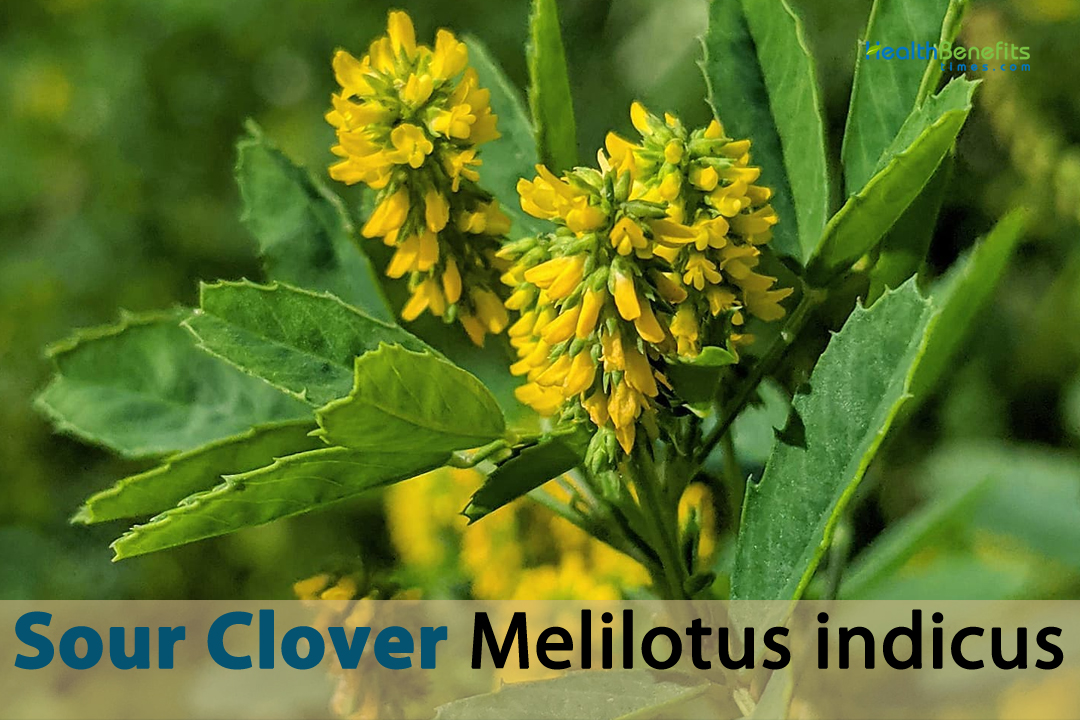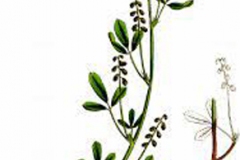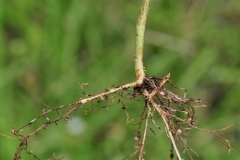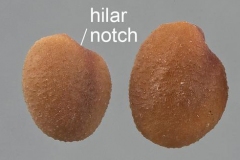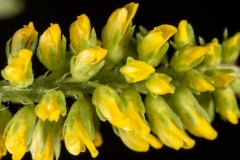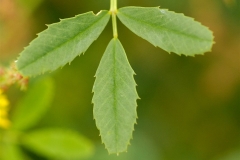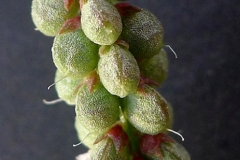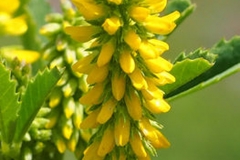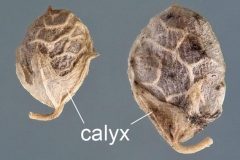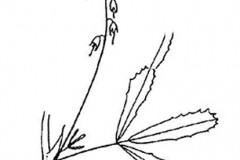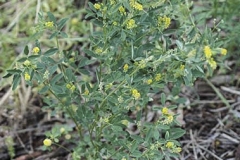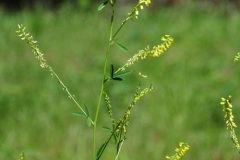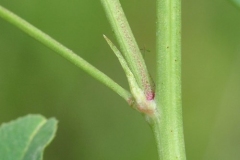The word “Melilotus” comes from the Greek words “meli,” which means “honey,” and “lotos,” which means “bean-like plant.” The word “indicus” at the end of the name of a species means that the plant is from India. The plant is sometimes taken from the wild to be used as food, medicine, or to keep insects away. As a green manure, it has been used. In some places, it can also be seen as an exotic plant. In some places, it is invasive because it can grow in a variety of places, makes a lot of seeds, and the seeds are easily spread by the wind. Herbalists and people who care about their health have both become interested in the plant. This one-of-a-kind plant has a long history of being used as medicine and has a wide range of health benefits. Sour Clover has a lot to offer, from the way it looks to the many ways it can help your health.
Sour Clover Facts
| Sour Clover Quick Facts | |
|---|---|
| Name: | Sour Clover |
| Scientific Name: | Melilotus indicus |
| Origin | Mediterranean and south-western Europe, and from India |
| Colors | Greenish color, turning light brown or straw-colored as they mature |
| Shapes | Small, elongated pods typically cylindrical or slightly curved, measuring around 2 to 3 centimeters in length |
| Taste | Mildly tart or lemony taste |
| Health benefits | Anti-Inflammatory Properties, Digestive Support, Rich in Antioxidants, Respiratory Health Support, Potential Anti-Cancer Effects, Vitamin C Boost, Potential Cardiovascular Benefits, Diuretic Properties, Analgesic Effects, Anticoagulant Activity, Wound Healing, Skin Conditions, Nutritional Content |
| Name | Sour Clover |
|---|---|
| Scientific Name | Melilotus indicus |
| Native | Mediterranean and south-western Europe, and from India. It became naturalized throughout most of the rest of the world including Europe, the United Kingdom, warm temperate North America (southern and Pacific USA), Chile, Australia, Japan, southern Africa, Hawaii, New Zealand, and is now widespread in all continents |
| Common Names | Sweet clover, sour clover, Indian sweet-clover, annual yellow sweetclover, Bokhara clover, small-flowered sweet clover, common melilot, small-flowered melilot, small melilot, sweet melilot, Californian lucerne and Hexham scent, hexham scent melilot, King Island melilot, King Island clover, senji, California lucerne |
| Name in Other Languages | Afrikaans: Geel stinkklawer Albanian: Makth, makthi indian, makthi lulëvogël Arabic: Handaquq, hindiquq hindiun (حندقوق هندي), Nafal, hindiquq muru (hindiquq murr), hindiquq hulw (حندقوق مر (حندقوق مُرّ)، حندقوق حلو), hundiquq (حندقوق), eutur (eatwr), eutur khadam (عطور (عَطور)، عطور خدم), hindiquq hindiun (حندقوق هندي), Ekleil almalik, handagog, Gard, Naflah, handagog bostani, Ghosn alban Assamese: Ban Methi (বন মেথী) Bengali: Banmethi (বন মেথী) Bulgarian: Indiĭska komuniga (индийска комунига) Catalan: Melilot de flor petita Chinese: Xiao hua cao mu xu, Ye mu xi, Yin du cao mu xi (印度草木犀), Xiǎo huācǎo mùxī (小花草木樨), Māo máo cǎo (猫毛草), Pì hàn cǎo (辟汗草), Pì hàn cǎogēn (辟汗草根), Yě mùxu (野苜蓿), yìn dù mù xi Croatian: Sitnocvjetni kokotac Czech: Komonica indická, Komonice indická Danish: Indisk stenkløver Dutch: Indische honingklaver, Kleinbloemige honingklaver, Kleine honingklaver English: Indian sweet-clover, King Island melilot, Small-flowered melilot , Small-flowered sweet clover, Small melilot, Sour-clover, Annual yellow sweet clover, California lucerne, Hexham-scent, Hexham-scent melilot, King Island-clover, Snall melilot, Smaller yellow melilot, Scented trefoil, snall melilot, Indian sweetclover Estonian: India mesikas Finnish: Intianmesikkä French: Mélilot à petites fleurs, Mélilot de l’Inde, Mélilot des Indes, Mélilot d’Inde, mélilot de l’Inde, trèfle musqué German: Indische honigklee, Kleinblütiger Steinklee, indischer Honigklee, indischer Steinklee, kleinblütiger Honigklee Hebrew: Divshah haddit, dbshh hdis (דִּבְשָׁה הָדִּית) Hindi: Senji, Ban methi (बन मेथी), Morila, Senji methi Hungarian: Indiai somkóró Italian: Meliloto a fiore piccolo, Meliloto d’India, trifoglio muschiato Japanese: Ko shinagawa hagi (コシナガワハギ) Marathi: Ran methi (रान मेथी) Nepali: Methi ghans (मेथी घाँस) Northern Sami: Indiamiehtaluovvar Norwegian: Orientsteinkløver Persian: یونجه زرد هندی Polish: Nostrzyk Indyjski Portuguese: Anafe-menor, Trevo-de-cheiro, Trevo-de-namorado, trevo-doce-amarelo Russian: Donnik indiyskiy (Донник индийский) Sanskrit: Vanamethika (वनमेथिका) Slovak: Komonica indická Slovene: Indijska medena detelja Spanish: Carretón oloroso, Coroa-de-rei, Meligón, meliloto de flor pequeña, Melilot de flor petita, Meliloto, Mielca borde, Trébol de olor, Trébol femella, Trébol oloroso, Trèvol d’olor, trébol oloroso, trebillo, trevillo, trévul, trébol amarillo Swedish: Dvärgsötväppling. Turkish: Küçük taş yoncası, otuzlu yonca Ukrainian: Burkun indiysʹkyy (Буркун індійський) Upper Sorbian: Kwěćikaty komonc Welsh: Gwydro Blodau Bach, Yr Wydro Blodau Mân |
| Plant Growth Habit | Erect, flowering, annual herbaceous legume plant |
| Growing Climates | Gardens, grassland, roadsides, fields, waste places, disturbed sites, coastal salt marshes, freshwater wetlands, riparian habitats, cultivated fields, irrigated crops, near water bodies, in river valleys, on seaside sands, in inhabited areas, on exposed stony-debris slopes, open places and alkaline soils of meadow |
| Soil | Does well on a wide range of soil types with preference for well-drained neutral or alkaline soils with a pH range of 6.0 to 7.5. The soil should be moderately fertile and have good moisture retention while avoiding waterlogged conditions |
| Plant Size | About 1 to 3 feet (30 to 90 centimeters) |
| Root | Taproot system. From the taproot, numerous lateral or secondary roots branch out horizontally. These lateral roots extend and spread throughout the soil, helping the plant absorb water and nutrients |
| Stem | Stem is erect and typically reaches a height of 60-150 cm (24-59 inches). It has a cylindrical shape with a slightly ribbed or grooved surface. Stem is herbaceous, meaning it is non-woody and flexible |
| Leaf | Alternate, trifoliate (consisting of three leaflets), and have toothed margins. The leaflets are oblong or lanceolate in shape and have a smooth or hairy surface |
| Flowering season | June to October |
| Flower | Small and delicate, typically measuring around 1 to 1.5 centimeters in length. They form dense clusters or spikes, creating a visually captivating display. The flower color can vary, ranging from pale blue and purple to white |
| Fruit Shape & Size | Small, elongated pods typically cylindrical or slightly curved, measuring around 2 to 3 centimeters in length with a smooth texture |
| Fruit Color | Greenish color, turning light brown or straw-colored as they mature |
| Seed | Seeds are ovoid, glabrous, yellow-brown, about 2 mm in length. They may be hard-seeded (about 5 to 20%) and thus will not germinate in the first year |
| Flavor/Aroma | Grassy or slightly citrus-like, with hints of green and earthiness |
| Taste | Mildly tart or lemony taste |
| Plant Parts Used | Leaves, flowers and stem |
| Propagation | By seeds, division, stem cuttings, Rhizome Division and runners or stolons |
| Lifespan | Single year to several years, depending on the species and the specific conditions in which it is grown |
| Available forms | Herbal teas, infusions, tinctures, and poultices |
| Health benefits |
|
| Other Facts |
|
Plant Description
Sour Clover is an annual grass legume plant with beautiful flowers that grows straight up. It usually grows to be between 30 and 90 centimeters (1 to 3 feet) tall. But it’s important to remember that this height can change depending on things like how the plant grows, how good the dirt is, and how much sunlight it gets. It may sometimes be a little taller or shorter than the average height.
This plant can grow well in many different places, such as gardens, grasslands, riparian habitats, roadsides, fields, inhabited areas, waste areas, coastal salt marshes, irrigated crops, freshwater wetlands, seaside sands, cultivated fields, open spaces, near water bodies, river valleys, exposed stony-debris slopes and alkaline soils of meadows and roadsides. It can grow in many different types of soil, but it does best in well-drained neutral or alkaline soils with a pH between 6.0 and 7.5. For the best growth, the soil should have a normal amount of nutrients, hold on to water well, and not be too wet.
Roots
Sour Clover has a taproot, which is a strong vertical root that goes deep into the ground. From this main root, or taproot, a large network of branch or secondary roots grow out in all directions. These side roots are very important for the plant to be able to get water and nutrients from the dirt.
One interesting thing about Sour Clover is that it can work together with bugs called rhizobia that fix nitrogen. These good bacteria live in special root clusters that form on the side roots. Rhizobia live in these nodules and change nitrogen from the air into a form that plants can use. This adds nitrogen to the soil. This amazing process, called nitrogen fixation, not only helps the Sour Clover grow and develop, but it also makes the earth more fertile as a whole.
Stem
Sour Clover has a straight stem that can be anywhere from 60 to 150 cm (24 to 59 inches) tall. It is round and has a surface that is slightly ribbed or grooved. Since the plant is a herb, the stem is not hard and can bend. It grows straight up from the bottom and spreads out into branches as it gets closer to the top. This structure of branches helps give the plant a thick look that is pleasing to the eye.
The stem is an important part of the plant because it moves water, nutrients, and sugars from one part of the plant to another. It acts as a transportation system, making it easier for the resources needed for different biological processes to move around. Also, the stem is a very important part of the plant because it gives it structure. Its upright nature helps the plant keep its upright position, which lets it use sunshine for photosynthesis and other important physiological processes. It’s important to remember that the stem’s features and adaptations can change based on things like environmental conditions, the age of the plant, and genetic diversity within the species.
Leaves
Sour Clover has alternate leaves, which means that each leaf is connected to the stem at a different place and moves to the opposite side as you go up. The fact that these leaves are made up of three leaflets gives them a trifoliate shape. The leaves are all joined together by a stalk called a petiole.
Most leaves are either oblong or lanceolate, which means they are longer than they are wide. They might have a sharp tip or peak. The edges or borders of the leaflets can have patterns that look like small, sharp teeth. These patterns are called toothed or serrated. The surface of the leaflets can be smooth or a little hairy, depending on the type of plant and the environmental factors at the time. The leaves have large veins that run through them and allow water, nutrients, and sugars to move through the plant. These veins are very important because they allow the plant’s key resources to move around inside the plant.
Flowers
The flowers of Sour Clover are usually between 1 and 1.5 centimeters long and are very small and delicate. They group together in thick clusters or spikes that are beautiful to look at. The colors of these flowers range from light blue and purple to pure white, giving any scenery or flower arrangement an elegant touch.
One thing that makes these flowers stand out is that they smell sweet and nice. When they are in full bloom, they give off a sweet smell that attracts pollinators like bees, butterflies, and other helpful bugs. This attractive scent acts as a natural lure, making it easier for pollinators to do their important job and helping the plant reproduce successfully.
In some customs, these flowers are also important because of what they stand for. People often think of them as signs of beauty, innocence, and wealth. Because of this, they are often used as decorations, in religious rituals, or just to look at because they are beautiful.
Fruits
Sour Clover’s fruits are small, long pods that grow after the blooming stage. Most of the time, these pods are between 2 and 3 centimeters long and have a cylindrical or slightly bent shape. They have a smooth feel and a greenish color when they are young. As they get older, their color changes to a light brown or straw color. Inside these pods are many small seeds that are safe and sound.
The fruits of the Sour Clover plant have anywhere from one to ten seeds in each pod. They are a good source of food for many animals and birds. Granivorous species in particular eat these fruits, which helps the seeds inside to spread and helps the plant’s natural process of spreading.
Seeds
Small and round, the seeds of Sour Clover is usually a light brown color. They are sealed inside the adult pods that form after the flowers have died. These seeds are an important part of the plant’s reproductive cycle. They are the key to the plant’s growth and life.
Sour Clover grows and takes over new places by sending out seeds. When the pods are ready, they split open on their own, letting the seeds spread out into the world. This system lets the seeds move around with the help of wind, water, or other things. Eventually, they end up in places where they can sprout and grow into new plants.
In some parts of the world, the seeds of Sour Clover have been known to have oil in them. They have a lot of polyunsaturated fatty acids in their oil, which makes them a useful resource for making edible oil. This shows how many different things the seeds can do. Not only do they play a role in the life cycle of the plant, but they could also be worth money in some situations.
History
Sour Clover is originally from the Mediterranean area and some parts of Asia, but it has shown an amazing ability to adapt, which has helped it spread and become naturalized in many countries around the world. At the moment, this useful herb grows well in areas with temperate and subtropical temperatures in Europe, Asia, Africa, Australia, and the Americas.
Sour Clover has been known for its healing qualities for a long time, which has led to it being used a lot in traditional medicine. Ancient people, like the Greeks and Romans, thought it was very important for its healing properties. It was thought to have qualities that helped with digestion, reducing inflammation, and getting rid of toxins in the body. Sour Clover has been used in traditional medicine for a long time to treat everything from stomach and breathing problems to skin problems.
Health benefits of Sour Clover
Sour Clover is a plant that is often considered a weed but has several health benefits. Let’s delve into the detailed health benefits of sour clover:
1. Anti-Inflammatory Properties
Some of the chemicals in sour clover, like tannins and flavonoids, can help reduce inflammation. Chronic inflammation is linked to a number of health problems, such as arthritis, heart disease, and some cancers. Sour clover may help ease symptoms and improve general health by lowering inflammation.
2. Digestive Support
Sour Clover has been used for a long time to help digestion in traditional ways. It has natural acids that cause the body to make more stomach enzymes, which help break down food and make it easier to absorb nutrients. By doing this, it can help with stomach problems like bloating, gas, and heartburn. Sour Clover has also been known to help people have normal bowel movements and create a healthy environment in the gut. Its good qualities make it a useful ally for keeping the digestive system in good shape.
3. Rich in Antioxidants
Sour Clover is a good source of antioxidants, like vitamin C and flavonoids, which are important substances. Free radicals in the body cause a lot of damage, but these antioxidants help fight back against that. By making these dangerous molecules harmless, they help lower oxidative stress and protect cells from damage.
Sour Clover is good for your health in many ways because it has vitamins. Their actions improve health in general and may even lower the risk of long-term diseases like cancer and heart disease. By making the body’s protections stronger against free radicals, antioxidants help make the system healthier and more durable. If you eat Sour Clover, you can get a lot of these good compounds, which is good for your health and energy in the long run.
4. Respiratory Health Support
Sour Clover has qualities that help you cough up mucus, which is good for your respiratory health. These qualities can help relieve coughs, bronchitis, and congestion, which are all signs of lung problems. Sour Clover makes it easier to breathe and relieves respiratory discomfort by making it easier for mucus and phlegm to leave the respiratory system. Adding this herb to your routines for respiratory health can help improve your lung function and general health.
5. Potential Anti-Cancer Effects
New research suggests that certain chemicals in Sour Clover may have anticancer effects. In lab tests, these substances have shown that they can stop the growth of cancer cells. But it’s important to remember that more study is needed to fully understand what effect they might have on preventing and treating cancer in people. As more research is done, we will learn more about the possible benefits of Sour Clover when it comes to cancer. This will open the door for possible healing uses in the future.
6. Vitamin C Boost
Ascorbic acid, which is the formal name for vitamin C, can be found in large amounts in sour clover. Vitamin C is important for a lot of things that happen in the body, like helping the immune system work well, making collagen so that skin and connective parts stay healthy, and helping wounds heal quickly. Including sour clover in your diet can help you get the vitamin C you need every day. By adding this herb to your routine, you can improve your general health and help your immune system, skin, and healing processes work better.
7. Potential Cardiovascular Benefits
Studies have shown that some of the chemicals in sour clover, such as polyphenols and flavonoids, may help protect the heart. These chemicals have been linked to possible health benefits like improving blood flow, lowering the risk of blood clots, and affecting cholesterol levels in a good way. But it’s important to remember that more study is needed to fully understand and back up these possible benefits. As research continues, we will learn more about how sour clover affects the health of the heart and blood vessels. This could give us important information for future preventative and therapeutic uses.
8. Diuretic Properties
Sour Clover has diuretic effects that make you urinate more often and make you make more urine. This diuretic action can be helpful for reducing water retention, helping the body get rid of toxins, and making sure the kidneys work well. By making people urinate more, sour clover helps keep a healthy fluid balance and makes it easier to get rid of waste products. Adding this plant to your daily routine can help you feel better overall and keep your kidneys working well.
9. Analgesic Effects
Sour Clover has been used for pain relief for a long time because it has analgesic qualities. Studies have shown that this plant may have pain-relieving properties that can help with headaches, muscle pain, and menstrual cramps, among other types of pain. By adding Sour Clover to your wellness routine, you may find a natural way to relieve pain and improve your general health.
10. Anticoagulant Activity
Coumarins, which are found in sour clover, are known to stop blood from clotting. By stopping clotting factors from working, these substances can stop the blood from clotting too much. People who are more likely to get blood clots, such as those with heart disease or who are healing from surgery may benefit from this trait. By adding Sour Clover to their routine, people may be able to lower their chance of blood clots and improve the way their blood flows. In these situations, it is important to talk to a medical professional to get personalized help and direction on how to use Sour Clover.
11. Wound Healing
Sour Clover has been used topically to heal wounds for a long time. Extracts from this herb may have antimicrobial and wound-healing qualities, making it a good choice for treating minor cuts, scrapes, and skin infections. By putting Sour Clover extracts on the wound, people can speed up the mending process and possibly stop or treat microbial infections. But it’s important to remember that you should see a doctor for good wound care, especially if the wound is serious or the infection is bad.
12. Skin Conditions
Sour Clover has been used for a long time as a topical treatment for skin problems like rashes, eczema, and small cuts. It is thought to have calming and anti-inflammatory effects that can help stop itching and speed up the mending process. By putting sour clover directly on the skin, people may feel less pain and possibly see their skin heal faster. But it’s important to remember that if you have a serious or long-lasting skin problem, you should see a doctor to get a right diagnosis and treatment.
13. Nutritional Content
Sour Clover is a plant that has many health benefits and is also very healthy. It has a lot of vitamins, including A, K, and B-complex vitamins like riboflavin and niacin. Sour Clover is also a good source of important minerals like potassium, calcium, and magnesium, which are important for keeping the body working well. By adding Sour Clover to your diet, you can take advantage of its nutritional value, which helps your health and well-being as a whole.
Traditional uses and benefits of Sour Clover
- It has been used in traditional medicine to ease pain, reduce inflammation, help with digestion, and improve general health.
- It has been used for hundreds of years as a natural cure for many different illnesses.
- Traditional healers have used the root to treat pain from rheumatism, problems with the urinary system, and swelling.
- It has been used to treat a wide range of diseases, including problems with the lungs, the stomach, and the skin.
- Its dried leaves and flowers were often made into plant teas or poultices to relieve pain and help wounds heal.
- It is thought to make you hungry, improve digestion, and ease stomach problems like bloating, gas, and heartburn.
- It makes more pee and helps the body get rid of toxins.
- It has been used to get rid of water retention and help the kidneys work better.
- It has been eaten or put on the skin to bring down a fever.
- Its leaves or poultices have been put on small cuts, scrapes, and skin irritations to help them heal and provide relief.
- It has been used to treat rashes, eczema, and insect bites by putting it on the affected area.
- It is thought that the cooling and anti-inflammatory qualities of sour clover help relieve itching and pain.
- It has been eaten to give a natural energy boost and boost vigor.
- The seed is made into gruel and used to treat bowel problems and diarrhea in babies and young children.
- The plant is narcotic, irritant, soothing, drying, and very good at making you go to the bathroom.
- The seeds are made into a soup that is used to treat stomach problems and diarrhea in babies and young children.
- The plant is put on bumps and sores as a salve or a paste.
Culinary Uses
Sour clover has culinary uses due to its tangy and citrus-like flavor. Here are some common culinary uses of sour clover:
- Salad Ingredient: Sour Clover leaves are often added to salads to give them a tangy and refreshing taste. They add a unique taste to a variety of salad greens and are a great addition to a variety of salads. You can use these leaves whole or tear them up into smaller pieces and mix them with different veggies, fruits, and dressings to make a colorful and flavorful salad. Adding Sour Clover leaves to your meals gives them a unique flavor that is both refreshing and enjoyable.
- Sauce and Dressing Ingredient: The tart taste of sour clover is great for making sauces and dressings taste better. You can make a tasty herb sauce or salad by chopping or blending the leaves into small pieces. When you mix them with things like olive oil, lemon juice, garlic, and spices, you get a tangy and fragrant sauce that goes well with grilled meats, roasted veggies, salads, and so on. By adding sour clover to your dishes, you can give them a unique and delicious twist that makes them taste fresh and enticing.
- Soup and Stew Enhancer: Sour clover leaves are a great way to make soups, stews, and broths taste even better. When these leaves are added near the end of cooking, they give the dish a tangy and citrusy flavor. When added to vegetable-based soups, creamy soups, or hearty stews, sour clover leaves give the food a bright, crisp taste and make the flavors more complex. Their addition improves the taste of the food as a whole, making ordinary dishes taste like something special.
- Herb Infusion: Sour clover leaves can be added to a variety of drinks to make them taste better. For example, putting the leaves in vinegar for a while makes tangy herb vinegar that can be used in sauces, marinades, or as a condiment. In the same way, putting the leaves in oil makes spicy herb-infused oil that can be used to cook, drizzle over food, or dip bread in. These infused products improve the taste of different dishes, giving them a delicious new twist and making the whole dining experience better.
- Beverage Flavoring: Sour clover is a versatile way to add taste to a wide range of drinks. By letting the leaves soak in hot water for a while, you can make a citrusy herbal tea that wakes you up. Also, these leaves can be added to iced teas, lemonades, cocktails, and mocktails to give them a tangy and refreshing flavor. The leaves can be blended or used as a garnish to make the drink look nicer. When you use sour clover to make a drink, it adds a unique and energizing touch that turns regular drinks into tasty, zesty concoctions.
- Garnish: Sour clover leaves can be used to decorate and add taste to a wide range of dishes. They add visual interest and a burst of tangy flavor to meals, desserts, and drinks with their unique shape and bright green color. Whether they are used to top soups, salads, main courses, desserts, or drinks, they make the food look and taste better. Adding sour clover leaves as a garnish gives a dish a bit of freshness and makes it look nicer. This can turn an ordinary dish into something that looks great and tastes great.
Other Uses
Sour Clover has several uses and benefits
- Forage and Silage: Because it has a lot of protein and nutrients, sour clover is often grown as a feed item for animals. This makes it a useful source of feed that animals need to stay alive. The nutritional value of the plant helps improve the health and well-being of animals as a whole. Sour Clover can also be used to make silage, which is a food for animals that is made by fermenting and storing the plant. By using Sour Clover in animal husbandry, farmers can improve the quality of feed for cattle and help animals get the best nutrition possible.
- Bee Forage: Sour Clover leaves are able to attract bees and other pollinators, which makes them a good source of nectar for making honey. By giving these important insects food, Sour Clover helps to keep the ecosystem in order and increase biodiversity. The mutually beneficial link between Sour Clover and pollinators helps make honey and keeps bee populations healthy. This relationship shows what a big part Sour Clover plays in promoting biodiversity and keeping the delicate environments where it grows healthy.
- Ornamental Plant: Sour clover is often grown as a decorative plant, mostly because its three-leaved leaves and small flowers look nice. It adds a cute touch to parks, flower beds, and even containers, making these places more interesting to look at. Sour Clover’s beautiful leaves and bright flowers add a burst of color and a touch of style to any landscape or arrangement. Sour Clover is a beautiful plant that looks great on its own or with other decorative plants.
- Soil Improvement: Sour Clover is known for being good for the health of the land. As a nitrogen-fixing plant, it has the special ability to take nitrogen from the air and turn it into a form that can be used to improve the soil. Because of this, it is a great choice as a cover crop or green manure plant, which improves the soil’s nutrients. By using Sour Clover in farming, farmers can increase the amount of nutrients in the soil, make farming more sustainable, and improve the long-term health of the soil. Its role as a natural soil improver shows how important it is to healthy agriculture and the balance of ecosystems.
- Erosion Control: Sour Clover is great for stopping runoff because it grows quickly and in a dense way. This versatile plant can be put on slopes, along riverbanks, and in other places where soil is likely to wash away. By doing this, it helps to stabilize the dirt and stop it from washing away. Sour Clover grows in a strong way that helps hold the soil particles together. This makes it less likely that wind or water will move the soil. Using Sour Clover to stop erosion helps keep the soil from breaking down, protects sensitive areas from erosion, and helps the environment stay healthy.
- Companion Planting: Sour Clover is a great plant to grow in parks with other plants because it helps them in many ways. Its thick leaves act as live mulch, stopping weeds from growing and keeping the soil moist. Sour Clover helps make a healthier yard environment by covering the soil’s surface. This keeps weeds from growing and keeps water from evaporating.
- Dyeing: The natural colors in the leaves of Sour Clover could be used to make dyes. When these leaves are used to dye fabrics or fibers, they can make shades of yellow or green. Some tribes still use Sour Clover as they always have to make natural dyes. The natural pigments in Sour Clover leaves can be used to dye fabrics in a way that is good for the environment and lasts for a long time. This means that manufactured dyes aren’t needed to make bright and unique colors. Using Sour Clover as a natural dye is a traditional way of doing things that connects people to their cultural history and encourages textile production methods that are good for the environment.
- Folklore and Cultural Significance: Sour Clover has a place in culture and is a big part of tradition in many places. In some traditions, it has a lot to do with luck, security, and keeping evil spirits away. Sour Clover has been used in ceremonies, celebrations, and symbolic practices in many different countries around the world throughout history.
- Wildlife Food Source: Some animals, like birds and small mammals, eat the flowers and seeds of Sour Clover because they are a good source of food. When Sour Clover grows in an area, it feeds animals that live there. This makes the area more diverse. Sour Clover adds to the ecological balance of the ecosystem by providing food for the many different species that depend on it. This interaction between Sour Clover and wildlife shows how species are all related and how important it is to protect habitats that keep nature’s delicate balance.
- Edible Flowers: The tiny yellow flowers of Sour Clover are not only pretty to look at, but they can also be eaten. This makes them a great addition to salads, sweets, and drinks. These flowers can be used as decorations to make foods look nicer and give them a hint of floral flavor. Sour Clover flowers add a touch of color and a light taste to a dish, whether they are used as a garnish or as part of the dish itself. This improves the overall dining experience. When you use these edible flowers in your cooking, you can experiment with new flavors and add a pleasant floral scent to your dishes.
- Natural Fabric Dye: You can get natural colors for fabrics and fibers from the leaves and stems of plants. By boiling the plant material, you can get a yellow or greenish dye that can be used in eco-friendly dyeing projects or cloth arts.
- Herbal Bath: As a natural plant medicine, sour clover can be added to a warm bath. It is thought to have calming effects and may help relax muscles and make you feel more at ease. Putting the leaves in the bathwater can make it smell good and help you feel better.
- Potpourri and Aromatherapy: Sour clover’s dried leaves and flowers can be added to potpourri or sachets to give a citrusy scent to a room. People often think of the smell as fresh, and it can be used in aromatherapy to make people feel better and make the surroundings more pleasant.
Precautions
While sour clover has culinary and potential medicinal uses, it’s important to exercise caution and be aware of the following precautions:
- Oxalic Acid Content: Sour clover has oxalic acid in it, which, in large amounts, can stop calcium from being absorbed and cause kidney stones in people who are prone to them. If you have had kidney stones, oxalate disorders, or health problems linked to calcium in the past, it’s best to limit how much sour clover you eat and talk to a doctor.
- Allergies: Some people may be allergic or sensitive to plants in the Oxalis family, which includes sour clover. If you know you’re allergic to plants, it’s best to be careful and avoid eating or touching sour clover so you don’t have any bad responses.
- Medication Interactions: Some medicines may not work well with sour clover. For example, the amount of vitamin C in it may change how well some blood-thinning medicines work. Before using sour clover as a medicine, you should talk to a doctor or nurse if you are on any medicines or have any health problems. This is to make sure there won’t be any drug interactions or bad side effects.
- Identification: It’s important to know how to recognize sour clover so you don’t mix it up with poisonous or dangerous plants. Before you eat or use sour clover, make sure to get information from trusted sources or ask an expert.
- Moderation: Like any other food or plant, sour clover should be eaten in small amounts. Even though it might be good for your health, too much of it could upset your stomach or cause other problems. Keep a healthy diet and think about how many different kinds of foods and herbs you eat.
- Pregnancy and Breastfeeding: If you are pregnant, trying to get pregnant, or nursing, it is best to err on the side of caution and not use sour clover or any other herbal remedies before talking to a doctor. There isn’t much known about how safe sour clover is during these times.
References:
https://www.feedipedia.org/node/273
https://www.itis.gov/servlet/SingleRpt/SingleRpt?search_topic=TSN&search_value=503741#null
http://www.hear.org/pier/species/melilotus_indicus.htm
https://npgsweb.ars-grin.gov/gringlobal/taxon/taxonomydetail?id=24000
https://gd.eppo.int/taxon/MEUIN
https://pfaf.org/user/Plant.aspx?LatinName=Melilotus+indicus
https://en.wikipedia.org/wiki/Melilotus_indicus
https://indiabiodiversity.org/species/show/245346
http://www.theplantlist.org/tpl1.1/record/ild-31598
http://www.flowersofindia.net/catalog/slides/Indian%20Sweet%20Clover.html
https://tropical.theferns.info/viewtropical.php?id=Melilotus+indicus
https://plants.usda.gov/home/plantProfile?symbol=MEIN2


